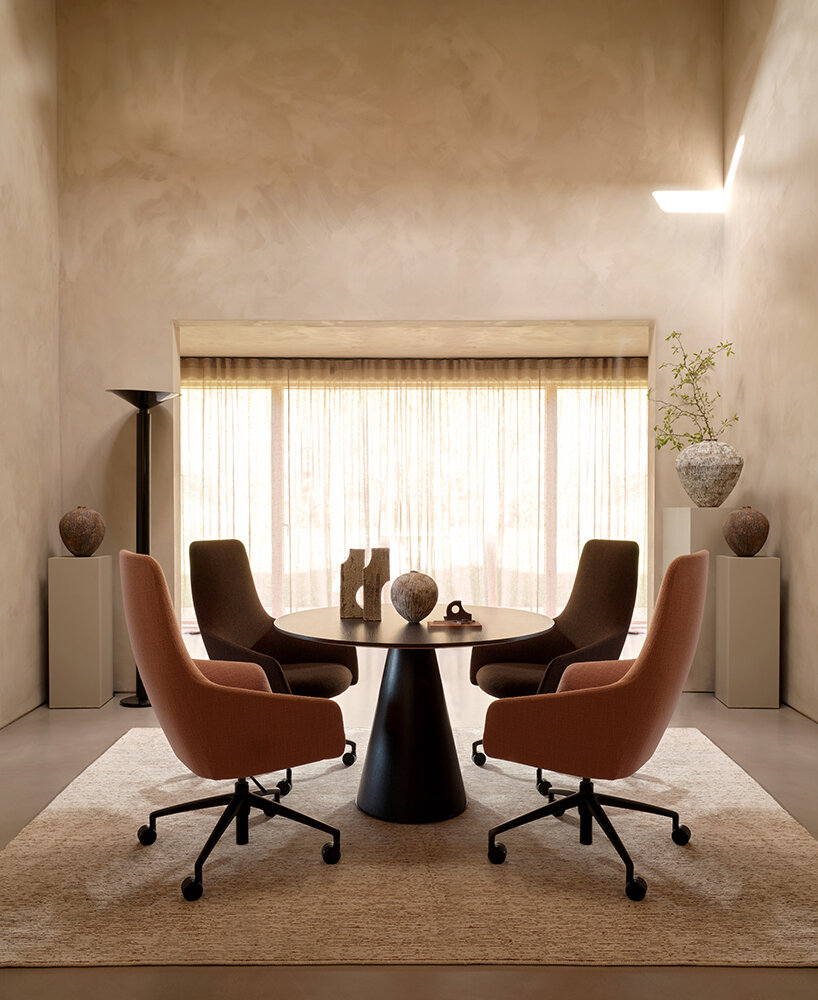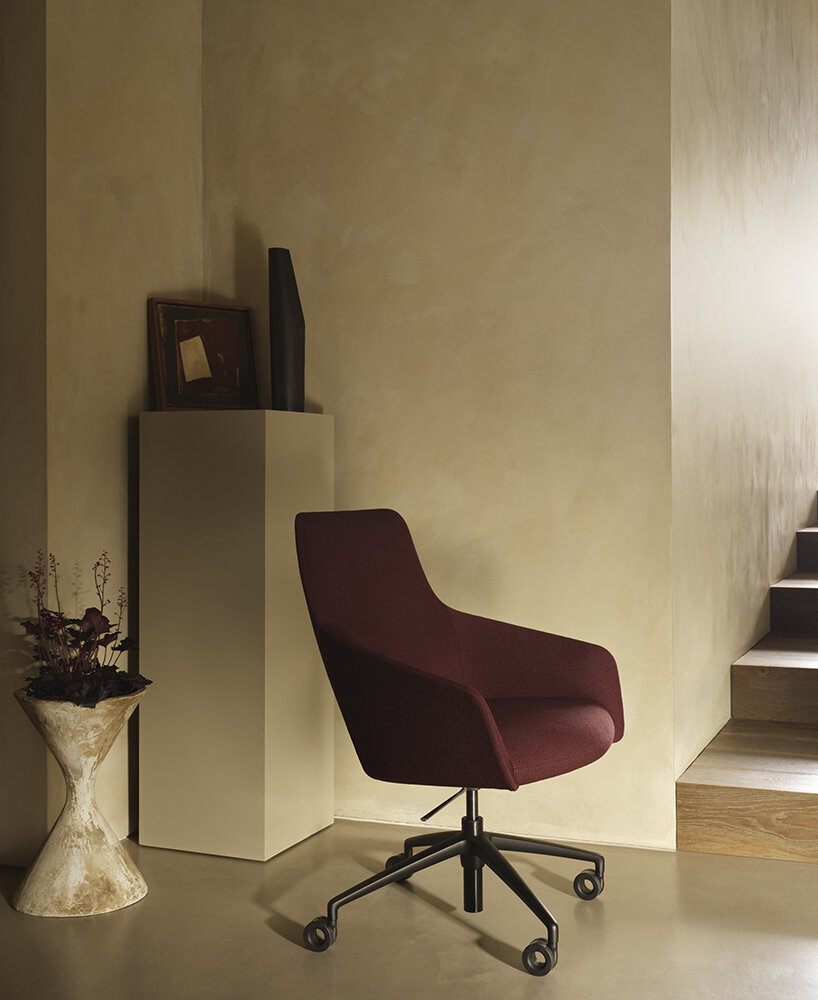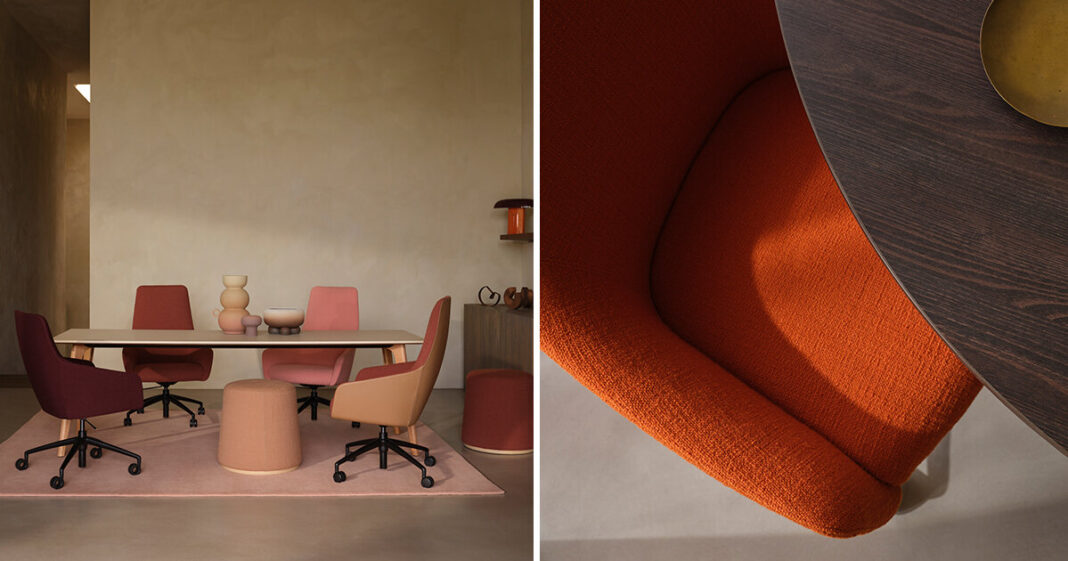boss design sets high seating standard with uma
Uma by Boss Design embodies a new standard in leadership seating, merging sculptural elegance with tangible sustainability. Drawing from nature, its organic form and tactility present a softer vision of authority – one rooted in ergonomic integrity and material responsibility. At a glance, the Uma chair appears poised, but beneath its elegant exterior lies a sophisticated fusion of material science and design engineering. The chair’s posture belies its low-impact footprint, made possible by the integration of BioPUR® foam – a revolutionary bio-based alternative that reduces embodied carbon by up to 75% when compared to traditional polyurethane. With Uma, Boss Design stands as a refined expression of how circular thinking can reshape timeless workplace icons.
Boss Design introduces Uma | all images courtesy of Boss Design
boss design in championing transparency through sustainability
Boss Design, headquartered in High Point, North Carolina, merges artisanal craftsmanship with forward-thinking European design. Known for creating destination furniture for commercial and hospitality spaces, the brand is deeply rooted in material integrity and environmental accountability. Their latest release, Uma, extends this philosophy – a chair born from customer demand and brought to life through sculptural refinement, functional excellence, and a transparent life cycle approach.
Built in the USA with materials sourced from domestic suppliers, Boss Design emphasizes both regional manufacturing and reduced environmental impact. As part of the Boss Design Group, founded in the UK in 1983, the company has long upheld a design ethos where aesthetics, utility, and responsibility are treated as inseparable.

Uma has been designed for maximum comfort with every surface, line and detail honed
uma’s executive presence with modular application
While Uma was conceived with boardrooms in mind, its adaptability extends far beyond. Upholstered in premium leather, it commands attention in executive spaces; dressed in playful patterned textiles or two-tone fabrications, it becomes a casual and inviting piece for breakout areas, lounges, or touchdown spaces. With a gently sculpted form, high integrated back, and smoothly contoured armrests, Uma maintains a consistent design identity that harmonizes with the broader Boss portfolio, including collections like Paloma, Amelia, and Remi. Its tailored silhouette and subtle seam detailing allow for seamless visual continuity across workplace typologies, offering designers a flexible, cohesive solution.
Uma’s visual softness belies the structural intelligence beneath its surface. The seat’s generous cushioning is supported by an intelligently recessed plywood base that allows for an extra 15mm of foam without compromising profile or form. This not only enhances comfort but exemplifies Boss Design’s nuanced approach to ergonomic layering. The chair’s backrest—flowing naturally with the spine—includes an inset lumbar panel of lower-density BioPUR® foam that subtly boosts support exactly where it’s needed, especially during extended periods of sitting. Firm perimeter edges offer structure and definition, while the plush center seat cradles the body, producing a sensation more akin to lounge seating than typical task chairs.

Uma’s enticing form is more than justified by its generously cushioned seat, supportive back and tactile arms
At the heart of Uma is BioPUR®—Boss Design’s proprietary foam formulation developed to significantly cut emissions without compromising tactile performance. Made using bio-based content and cleaner chemistry, BioPUR® represents a major stride toward decarbonizing upholstered furniture. Its integration into Uma is not cosmetic but foundational: the foam is fully embedded within both the seat and backrest, delivering enveloping softness while maintaining ergonomic fidelity. More than just a material choice, BioPUR® is central to Boss Design’s commitment to measurable sustainability. Each Uma chair carries a carbon certificate based on third-party life cycle assessment methodologies aligned with the GHG Protocol and ISO 14067 standards.
Durability is another cornerstone of Uma’s sustainable design. Its internal skeleton features a robust steel frame, while the base, available in four- or five-star cast aluminium, is both lightweight and long-wearing. Functional enhancements such as height adjustment, a swivel mechanism, and a lockable tilt function make Uma suitable for daily use, whether as an executive desk chair or a dynamic conference seat. When it reaches the end of its first lifecycle, Uma can be easily reupholstered or refurbished thanks to its component-driven design. Every material – from foam and fabric to plywood and metal—has been chosen for its ability to be cleanly disassembled, reused, or recycled in alignment with circular economy principles.

